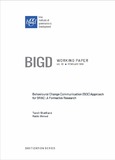Behavioural Change Communication (BCC) approach for BRAC: A formative research
Date
2019-02Publisher
BRAC Institute of Governance and Development (BIGD)Metadata
Show full item recordAbstract
As a part of social development, BRAC has been working in the Behavioural Change Communication (BCC) areas of its program participants for decades. Facing a revolutionary technological change, it is time to rethink the effectiveness of the conventional BCC tools and revise them if necessary. This study revealed the existing patterns of cultural and recreational activities at the community level that can be broadly categorized into seasonal, periodic, and everyday entertainment. Different modalities and purposiveness of entertainment, such as secular entertainment, religious entertainment, sports-based entertainment, national interests, local market-oriented entertainment, mobile-oriented entertainment, cable network and television, social media, were found to exist in the community. It was also found that a significant change has occurred in the span of everyday entertainment in both rural and peri-urban areas. This entire context was in such a phase that the information and communication technology developed in a noteworthy way. As a result, the sources of entertainment and information became personalized, localized, and digitalized. The advancement of technology created a new form of “digital and virtual culture” in the community. Mobile phones had become a vibrant source of entertainment and information, shaping a notion of personalization of information and entertainment among the community people. Since internet packages offered by different mobile operators were expensive, both in rural and peri-urban areas people did not have significant access to the internet. But they had another organized structure through which they obtained digital contents and stored them on their electronic devices. Orienting this exchange of digital contents, an informal market mechanism emerged in the community which was also explored in this study. Finally, it emerged from the cases of BRAC’s conventional BCC practices in the community that printed pictorial posters and flipcharts (conventionally used by BRAC) were losing their appeal to the target audience. Based on the findings of the study, it is now important for BRAC to consider new approaches to information, communication, and education methods while preserving some of the effective conventional methods as well.

